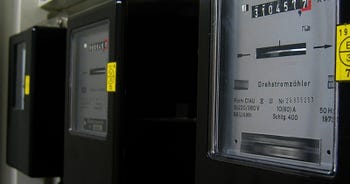What is biomass and what does it mean for UK small businesses?
With so many different ways of generating energy, knowing which is the right option to choose for your business can sometimes feel overwhelming, especially if you want to go down the renewables route. Renewable energy systems like solar panels and microtubrines are becoming increasingly popular but have you heard of biomass?
Although forms of biomass energy have been around for potentially millions of years, it’s only just getting the attention it deserves. In fact, biomass is a key component within the UK’s energy supply, with bioenergy generating 11% of the total electricity supply in 2022.
We've got you covered when it comes to learning more about this form of renewable energy — from understanding what it is to the benefits it can have on your business.

30-second summary
- Biomass energy is an organic, renewable source derived from plant materials. Biomass is produced in power plants and generates electricity by burning organic matter like wood, plants, crops, food or animal waste, for example.
- Although it is considered a renewable energy source, burning biomass does release some harmful pollutants. Some of the benefits of using biomass energy include waste reduction, energy diversification and fewer greenhouse gas emissions compared to fossil fuels.
- Businesses of all sizes should consider the following when looking at adopting biomass resource availability, type of technology, energy demand needed and costs.
What is biomass?
In ecological terms, biomass refers to any organic matter from living materials made of carbon. Biomass energy is a renewable source that can be used to generate energy, such as wood, plant materials or forest residues, to name a few.
While biomass releases carbon dioxide when burned, it is still less than what fossil fuels, like coal, produce.
How does a biomass power plant work?
Unlike traditional power plants that run on fuels such as coal or gas, a biomass power plant runs entirely on biomass.
When organic matter is burned for fuel, it creates steam, turning turbines to generate electricity. This system is very similar to how gas or coal-fuelled plants run, with the main difference being the fuel used and its effect on the environment.
But burning biomass isn’t the only way these materials are used to generate electricity. Gasification is another method where biomass is heated with less oxygen than is needed for proper combustion. This then produces hydrogen, which can be used as an alternative method of fuel in a power plant.
What is biofuel?
Biofuel is a type of renewable fuel that comes from organic matter, such as plants, agricultural residues, or waste materials, which undergo various processes to convert their biomass into usable energy sources.
These energy sources take the form of liquid fuels (biofuels) like biodiesel and ethanol, produced through complex processes like transesterification and fermentation. During these chemical processes natural plant oils are added to alcohol to change the composition of organic matter and then the molecules are broken down anaerobically.
Biofuels are considered environmentally friendly alternatives to fossil fuels. They can help reduce greenhouse gas emissions and dependence on finite resources, contributing to a more sustainable and cleaner energy future.
What are the different types of biomass?
There is a wide range of organic materials that can be used as a source of biomass energy.
These include:
- Wood — This is biomass derived from trees and woody plants. It can be used for heat, power generation or be converted into biofuels like wood pellets.
- Agricultural biomass — This includes crop residues like corn stalks, wheat straw, and rice husks. These materials can all be used for energy generation.
- Energy crops — These are specifically grown for energy production, such as switchgrass, miscanthus, and willow. They are cultivated for use as biomass for fuel.
- Food processing waste — Waste materials such as fruit peels, vegetable trimmings, and other byproducts are generated during food processing. These can be processed and converted into bioenergy.
- Animal manure — Waste from livestock and other animals can be used for biogas production through anaerobic digestion, which generates methane for energy.
- Algae — Microscopic aquatic plants that can be grown for their biomass, which contains oils that can be converted into biofuels like biodiesel.
- Aquatic plants — These include various plant species that grow in marine environments like ponds, lakes, and rivers. They can be harvested and used for biomass energy.
Is biomass environmentally friendly and sustainable?
Biomass is a somewhat sustainable energy source that can help reduce our dependency on fossil fuels. Since it’s renewable, it can be replenished over time, unlike coal, natural gas, oil and nuclear energy.
Although biomass is known as a renewable and environmentally friendly solution, it does have its drawbacks. One of biomass's biggest challenges is its contribution to air pollution.
When burned, biomass releases pollutants into the air — which can be harmful to human health, especially to people who suffer from respiratory conditions like asthma.
What are the advantages of using biomass energy?
On the other hand, there are also many benefits of using biomass energy for businesses and the environment.
- Waste reduction — Utilising biomass for energy encourages the responsible management of organic waste. By converting waste materials into useful energy sources, biomass energy helps reduce the burden on growing landfills and waste disposal systems.
- Reduce greenhouse gas emissions — When biomass is burned or processed for energy, it releases carbon dioxide (CO2), but the amount released is generally equivalent to the CO2 absorbed by the plants during their growth. This creates a carbon-neutral or carbon-negative cycle, which can help against greenhouse gas emissions and combat climate change.
- Diverse feedstock — Biomass can be sourced from a wide variety of materials, including agricultural residues, forest waste, and organic waste from households and businesses. This creates a ‘diverse feedstock’ of materials to be used and reduces the pressure on a single resource that has the potential to run out.
- Energy diversification — Biomass energy contributes to energy diversification by offering an alternative to fossil fuels. This can enhance the UK's energy mix, improving our energy security by reducing reliance on imported oil and natural gas.
- Renewable energy source — Biomass is renewable as it comes from natural plants and waste, which can be replenished through natural processes. This in itself makes biomass a renewable energy source, helping to reduce dependence on finite fossil fuels.
How long has biomass been used as a source of energy?
Biomass has been around for millennia — in fact, there’s plenty of evidence to suggest that humans have been using biomass energy even 230,000 and 1.5 million years ago.
For most of the earth’s existence, biomass energy consisted of mostly plant or animal material to fuel cookfires and the use of wood materials for heating.
Biomass is among some of the most straightforward energy sources of combustible carbon. This is why biomass energy is still widely used in developing countries, as they don’t have the infrastructure for generating large bioenergy systems.
How do I know if biomass energy is right for my business?
There are a few factors to consider when looking at how feasible using biomass energy is for your business.
- Resource availability and suitability — Consider if biomass resources are available and suitable - from agricultural residues and forest waste to energy crops and organic waste. Look at factors such as quantity, quality, sustainability, and potential environmental and social impacts of sourcing these resources.
- Technology selection — Research the right biomass conversion technology for your energy needs — consider options like combustion and gasification. Take into account its efficiency, scalability, and cost-effectiveness. If you’re not sure, look into hiring a consulting expert to help you make the decision.
- Energy demand and potential benefits — Analyse your business's energy consumption patterns and estimate the potential cost savings from using biomass energy. Compare these projected savings to your current energy costs to see whether you could save any money if you switch.
- Financial analysis — Estimate the initial investment you’ll need for equipment, construction, and general operations and then compare these costs to the projected revenue you could make. Make sure to consider all financial matters, including payback period and return on investment.
Are there any financial incentives or grants available for adopting biomass energy?
The ‘Biomass Feedstocks Innovation Programme’ is a £36 million programme funded through the Department for Energy Security that aims to increase commercial use of innovative clean energy technologies and processes throughout the next two decades. It also aims to increase the production of sustainable UK biomass feedstocks.
This programme closed to applicants on May 12, 2023.
Adopting renewable systems that use biomass energy could mean your business can get some relief on green taxes, like the Climate Change Levvy.
Get your business set with Bionic
Biomass can be a great alternative to more ‘traditional’ means of energy production. And, no matter the size of your business, even the smallest of changes can make a big difference.
If you need more help understanding business energy, head over to our energy guide pages for more information. Or, get in touch today with the Bionic team to compare your business energy needs, including electricity and gas.








